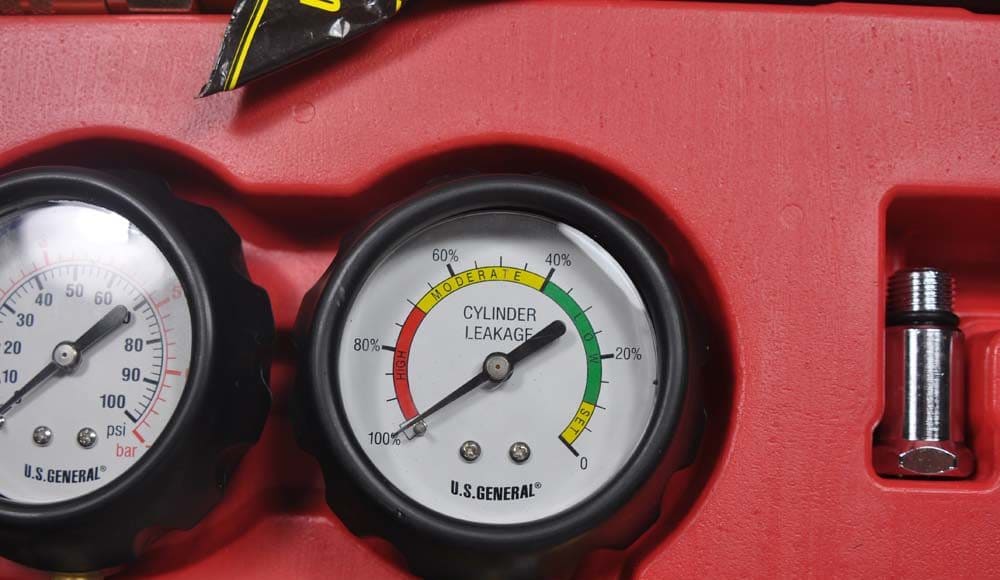Affiliate link disclosure – The BMW Repair Guide uses affiliate links in their site. For more information on affiliate links, please click here.
Repair Summary
The following article gives detailed instructions on performing a cylinder leak down test on a BMW E36 3 series car. Even though we have used a 1996 BMW M3 to perform this test, this article can be applied to any 1990-1998 3 series with minor modifications.
See all vehicles this article applies to
E36 3 Series 316i
E36 3 Series 318is
E36 3 Series M3
E36 3 Series 320i
E36 3 Series 325i
E36 3 Series 325is
E36 3 Series 323i
E36 3 Series 328i
E36 3 Series 318i
E36 3 Series 323i 2.4
E36 3 Series 325td
E36 3 Series 325tds
E36 3 Series 318tds
E36 3 Series 316i 1.6
E36 3 Series 323ti
E36 3 Series 318ti
E36 3 Series 316g
E36 3 Series 316i 1.9
Performing a BMW E36 cylinder leak down test is an easy way to gain insight into the condition of your piston rings and valves, especially when used in conjunction with a standard compression test.
Asking a seller about the maintenance history on a high mileage used car can often be comparable to asking your teenager what they did last night; most likely you won’t get the whole story, and what they do tell you is only partially believable. When the BMW Repair Guide purchased our 1996 BMW M3 project car (or as we like to say when we “saved it”) it had 215,000 miles on it. The seller was the fourth person to own the car, and his maintenance records were mostly recited from memory. We really had no clue what condition the engine was in.
Since we enjoy driving the Repair Guide M3 aggressively on the track, the time had come to find out more about what was going on under the engine covers. Reliability is a big concern for all purchasers of used BMWs...especially those being driven like a bat out of hell around a racetrack in South Florida. The leak-down test is a reliable tool to check the condition of your cylinder pressure and identify any problems that exist.
The point of a BMW E36 cylinder leak-down test is to check for and identify the source of any pressure loss when the cylinder is at the top of its compression stroke. These pressure losses can affect horsepower and torque, and can also be evaluated to identify whether it is a bad piston ring or faulty valve causing the problem. This very simple procedure is performed using a compressed air source and a tool called a cylinder leak down tester. Cylinder leak-down testers can be inexpensive (under $50) and should be an essential acquisition for your tool chest.




Before starting this repair, you must have the following required parts.
BMW E36 320i, 323i, 325i and 328i
Periodic spark plug replacement prevents many common problems caused by worn, contaminated plugs, including misfire, reduced power and fuel economy, and an illuminated Check Engine Light. Fresh plugs promote good engine performance and fuel economy, while reducing engine misfire that stresses and damages expensive ignition coils and catalytic converters.
BMW E36 325i, and M3
Periodic spark plug replacement prevents many common problems caused by worn, contaminated plugs. Fresh plugs promote good engine performance and fuel economy, while reducing engine misfire that stresses and damages expensive ignition coils and catalytic converters.
BMW E36 323i, 328i, M3 (S52 engine)
Ignition coils give your vehicle the spark it needs to make power. If the spark is weak or nonexistent, power will decrease as your engine is misfiring or not utilizing a cylinder. To restore that lost power and eliminate the misfire, replace your's now.
BMW E36 320i, 325i, M3 (S50 engine)
Ignition coils give your vehicle the spark it needs to make power. If the spark is weak or nonexistent, power will decrease as your engine is misfiring or not utilizing a cylinder. To restore that lost power and eliminate the misfire, replace your's now.
Section 1 - Preparing for the BMW E36 Cylinder Leak Down Test
- Remove nozzle from alternator air duct. Nozzle just unsnaps with no tools needed.
- Remove radiator air shroud with 8mm socket wrench and a flat blade screwdriver or auto body trim removal tool (preferred). Air shroud is held in place with two 8mm screws and two body panel retaining clips.
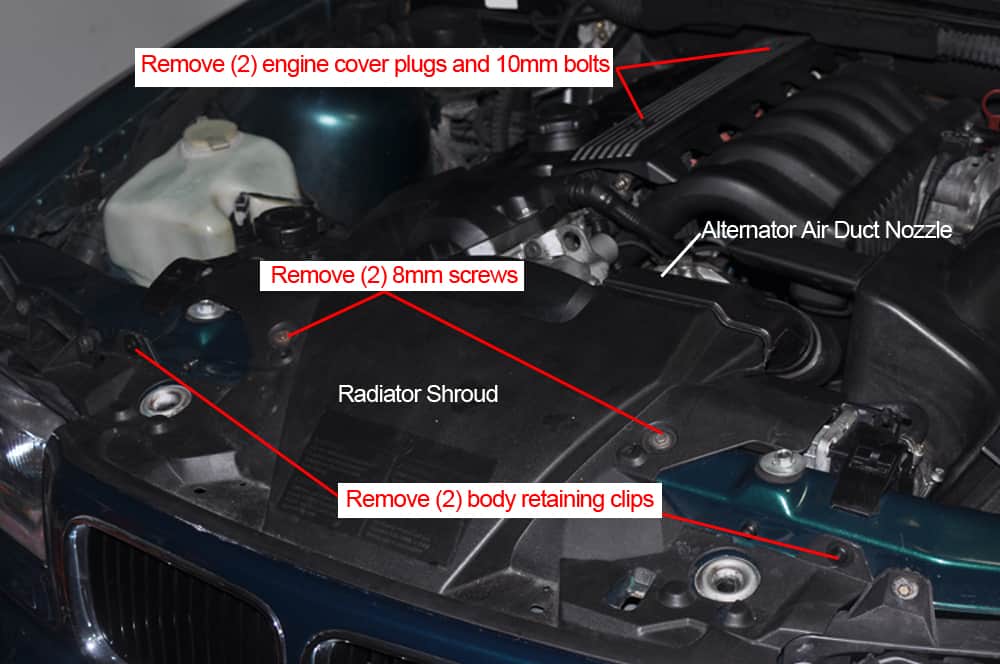
- Pop out the two engine cover plugs with a flat blade screw driver so bolts are visible. Remove engine cover with a 10mm socket wrench.
- Loosen then reinstall the engine fan using a fan clutch tool kit. The engine fan will eventually need to be removed so you can gain access to the crankshaft pulley. The reason why we suggest loosening and then reinstalling the fan before warming up the car is because many fans nuts have never been removed and may be difficult to get loose. It is always better to find out if the nut is coming off before heating up the car. Remember, the thread on the fan clutch nut has an opposite thread...this means you must turn it to the right when standing in front of the car to loosen it. Once the nut is loose, apply some grease to the threads and hand tighten by spinning the fan blade to the left. The engine fan nut is self tightening, so there is no need to use a wrench.
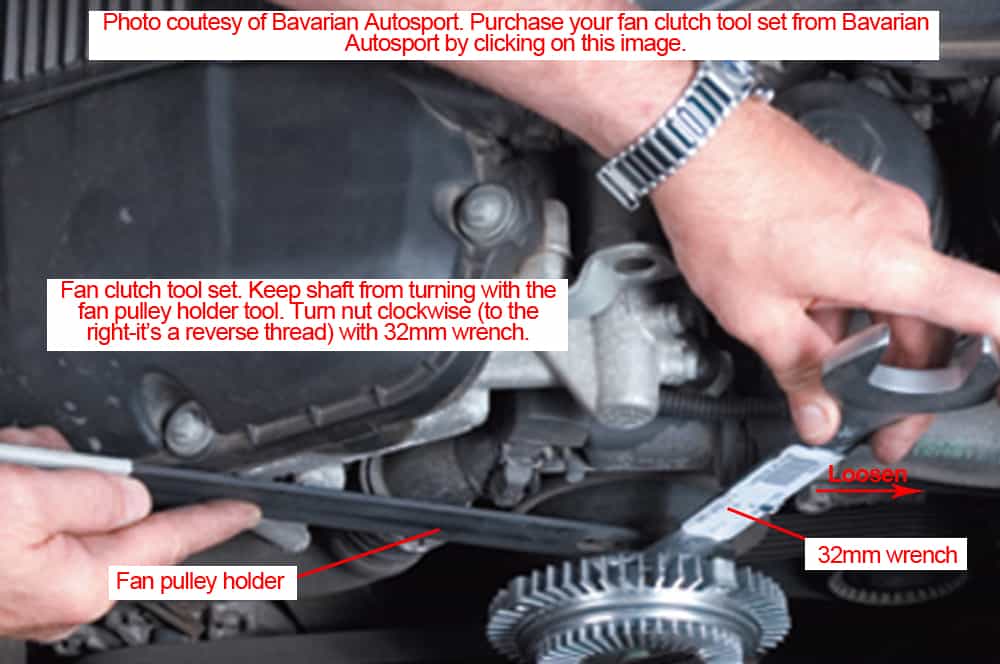
- Start engine and run until engine it reaches operating temperature (about 5 minutes).
Section 2 - Preparing for the BMW E36 Cylinder Leak Down Test: Part 2
- Loosen the fan shroud by removing the two body retaining clips found on either side of the radiator. Be prepared - these clips tend to disappear on older vehicles and are usually replaced with zip ties.
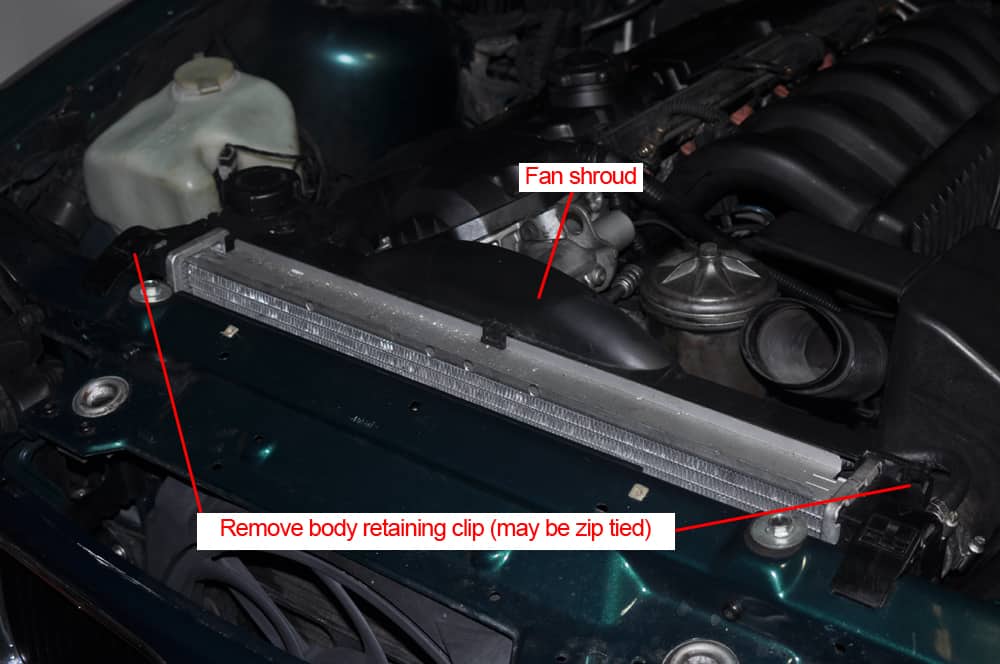
- Remove engine fan from car using fan clutch tool kit. You may have to pull up on the fan shroud to make room to get the fan out.
- Using a Sharpie or permanent magic marker, label each coil pack by numbering them "1" through "6", starting with the coil nearest the front of the car and moving backward toward the firewall. These are the engine cylinder numbers, and the coils should be later reinstalled in their correct order.
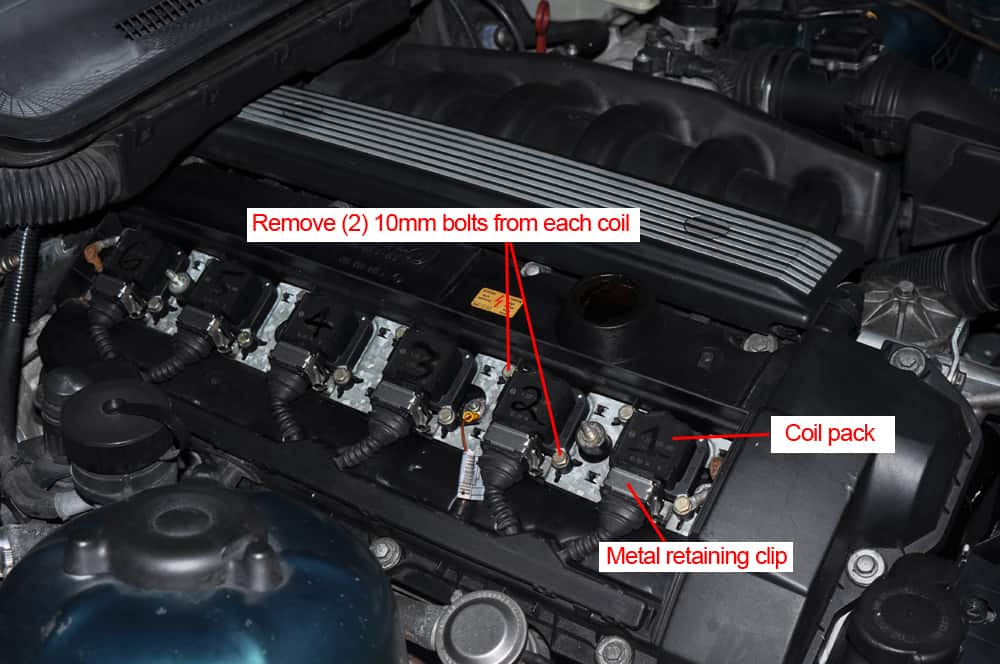
- Disconnect the six engine coil packs from their wiring harness by grasping the metal retaining clip between two fingers and lifting up. The connecting wire should slide out of the coil pack.
- Using a 10mm socket wrench, remove the two bolts holding each coil in place. Remove the coil from the spark plug by grasping them and pulling straight out.
- Remove the six spark plugs using a 5/8" spark plug socket. Mark the plugs with the Sharpie 1-6 to match the coils.
Section 3 - Finding "Top Dead Center"
In order to easily execute a BMW E36 cylinder leak down test, the number 1 piston must first be rotated to top dead center (TDC) on its compression stroke. When a piston is at TDC of its compression stroke, the intake and exhaust valves are firmly closed and the piston is at the top of the cylinder with the its connecting rod fully extended in its vertical position. As shown in the following diagram, if the cylinder is pressurized at TDC on the compression stroke, it should theoretically hold that pressure if the valves are properly closed and the piston rings are tightly sealed.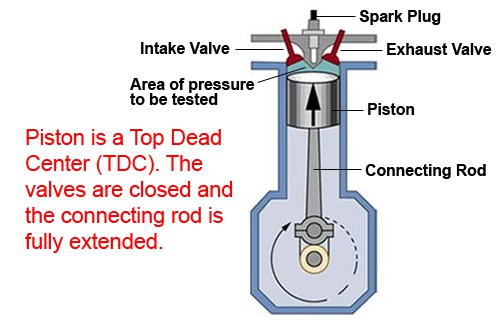 But in the real world, a certain amount of pressure escapes through the rings and valves, even on a new engine. This pressure loss is recorded on the cylinder leakage gauge of our test equipment, and can be used to make analytical assumptions of the condition of our engine and if the engine needs immediate attention.
But in the real world, a certain amount of pressure escapes through the rings and valves, even on a new engine. This pressure loss is recorded on the cylinder leakage gauge of our test equipment, and can be used to make analytical assumptions of the condition of our engine and if the engine needs immediate attention.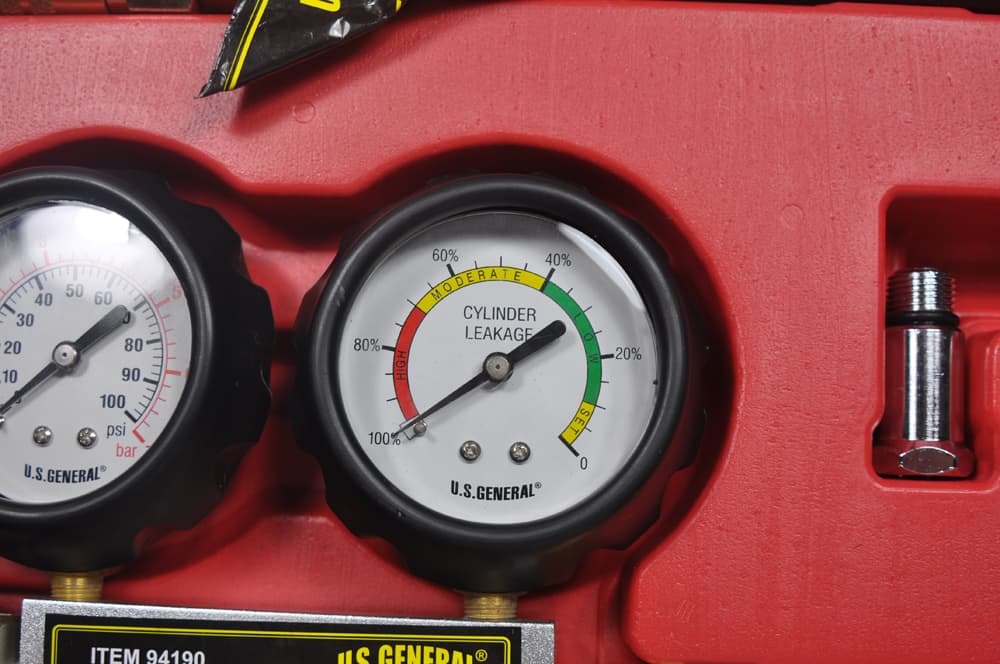 There are many articles on how to get a BMW E36 engine to TDC, and most of them make one of the following assumptions:
There are many articles on how to get a BMW E36 engine to TDC, and most of them make one of the following assumptions:- That you have a clear view of the TDC markings on the harmonic balancer or
- you have your valve cover off so you can view the position of the valves or
- you can put your finger on the spark plug hole and feel the pressure change as the piston approaches TDC on the compression stroke.
- get a clear view of the TDC markings on the harmonic balancer due to the thermostat, and other engine parts in the way. Using a mirror doesn't help either.
- view the valves because we have not removed the valve cover.
- Attach breaker bar with a 22 mm socket to the crankshaft pulley nut.
- Starting with cylinder 1, install the flexible adapter hose into the threaded spark plug hole until it is hand tight. Rotate the crankshaft pulley clockwise (to the right from the front of the car) while holding a finger tip over the opening in the adapter hose. When you feel the pressure from the adapter hose blow your finger off the end, the piston has approached TDC on the compression stroke.
- Remove the adapter hose and use the flexible inspection light to visibly confirm that the position of the piston is near the top of the cylinder.
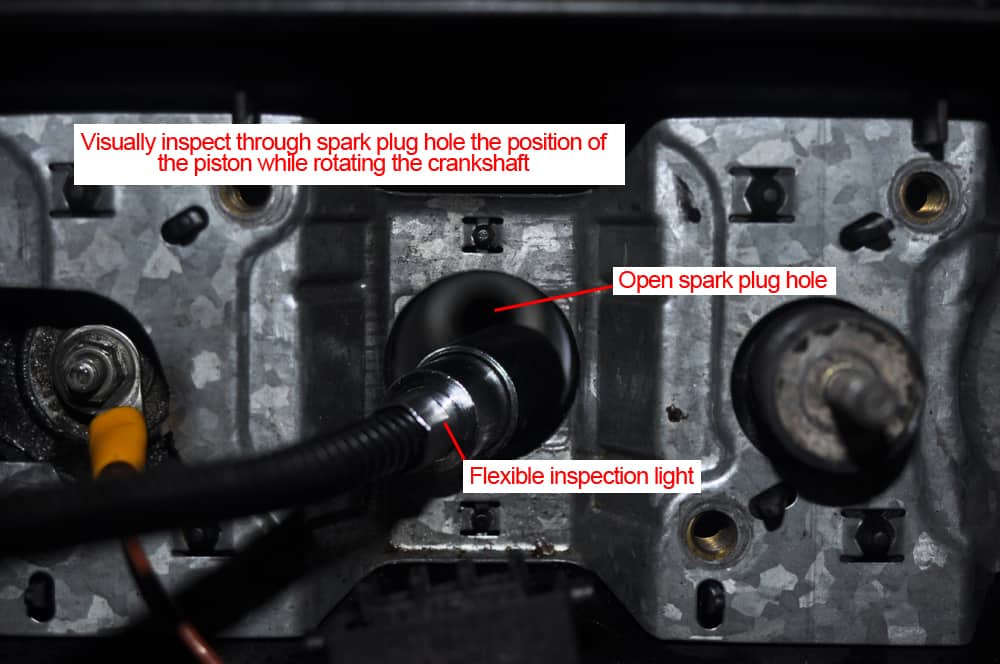
- Use the simple technique of "wiggling" the piston to get it into its final position for testing as follows:
- Push forward clockwise on the breaker bar until the piston moves slightly down. STOP. Mentally mark the position of the breaker bar handle.
- Now pull back on the breaker bar counterclockwise and watch the piston rise and the slightly fall again. STOP. Mentally mark the second position of the breaker bar handle.
- Now move the breaker bar forward clockwise again to the approximate half way position of the previous two steps, and you are now approximately at TDC. Wiggle the breaker bar back and forth several time to set the piston rings. You are now ready to test.
Section 4 - Test Cylinders for Leakage
- Reinstall the test kit adapter hose in the threaded spark plug hole and hand tighten. Make sure your compressor or air source is pressurized, and attach it to the test gauge. Turn the regulator handle on the tester all the way to the left-counterclockwise to release any pressure in the gauge, then slowly turn it to the right-clockwise until the the cylinder leakage needle on the right hand gauge reads "0".
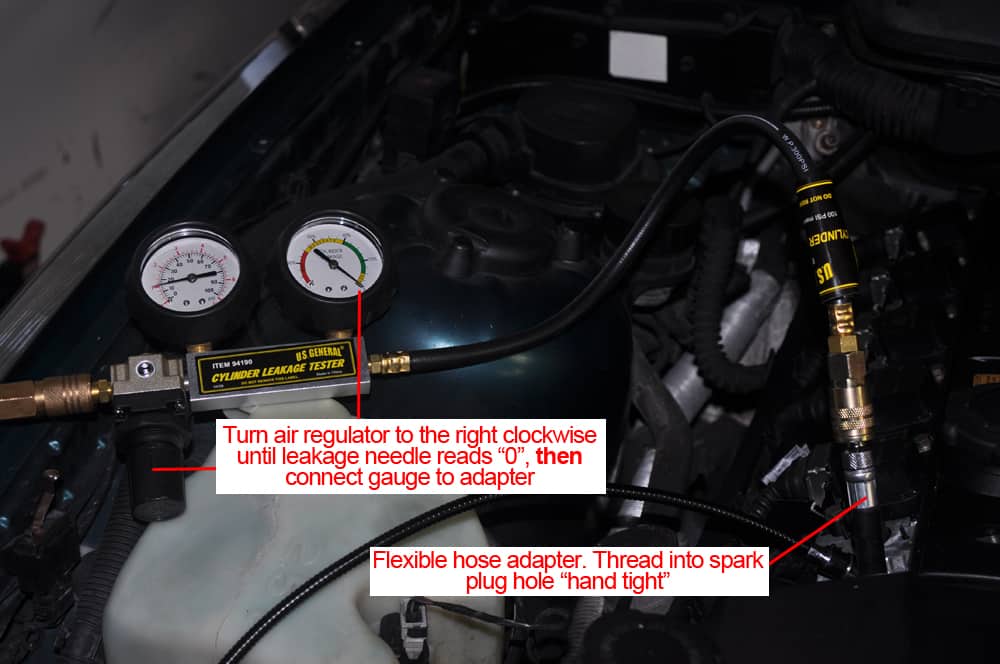
- Attach the test gauge to the adapter hose attached to the engine. The cylinder leakage needle will "jump" and settle on your percentage leakage for that cylinder. Record the number.
- The firing order for a BMW E36 6 cylinder engine is 1,5,3,6,2,4. This means after testing cylinder #1, you should move to cylinder #5, then to #3, on so forth until finished. Don't forget to document the gauge reading for each cylinder so you can review.
BMW E36 Cylinder Leak Down Test Finished

